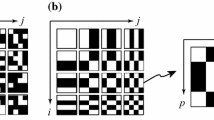Abstract
To meet the visual characteristics of human eyes, high resolution imaging technology came into being. In this paper, a high resolution reconstruction method of ghost imaging via SURF-NSML is proposed. Using the image registration method of Speeded Up Robust Features (SURF) and the fusion algorithm of New Sum of Modified Laplacian (NSML), a series of low-resolution images obtained by the ghost imaging system were registered and fused to obtain high-resolution images. This high resolution image reconstruction method does not need the use of spectroscopic devices, filters and other devices, simplifying the experimental equipment; and it is received by a bucket detector, which greatly increases the utilization of experimental equipment. By the reconstruction analysis of images from natural scenes and from the medical field, it is proved that this method combining the device platform with the language algorithm can reconstruct the target image with better visual characteristics and richer details, which has a good promotion effect on the research of image reconstruction.







Similar content being viewed by others
References
S. Rohani, D. Allen, B. Gare, High-resolution imaging of the human incudostapedial joint using synchrotron-radiation phase-contrast imaging. J. Microsc. 277, 61–70 (2020)
L. Haochang, Y. Zhao, Y. Guang, High resolution imaging based on photo-emission electron microscopy excited by deep ultraviolet laser. Acta Physica Sinica Chin. Edition 69, 096801 (2020)
D. Lowe, Distinctive image features from scale-invariant key points. Int. J. Comput. Vis. 60, 91–110 (2004)
H. Hong, H. Qiqiang, L. Xiaojun, Hierarchical spatial pyramid max pooling based on SIFT features and sparse coding for image classification. IET Comput. Vis. 7, 144–150 (2013)
S. Magdy, Y. Abouelseoud, M. Mikhail, Privacy preserving search index for image databases based on SURF and order preserving encryption. IET Image Process 14, 874–881 (2020)
Y. Toda, H.H. Yz, T. Matsuno, Adaptive evolution strategy sample consensus for 3D reconstruction from two cameras. Artif. Life Robot. 25, 466–474 (2020)
S. Xiaolong, W. Zhengyong, F. Yaoqing, Fast image fusion based on sum of modified Laplacian. Comput. Eng. Appl. 51, 193–197 (2015)
M. Paul-Antoine, P.A. Morris, T. Ermes, Experimental limits of ghost diffraction: Popper’s thought experiment. Sci. Rep. 8, 13183 (2018)
P. Moreau, E. Toninelli, T. Gregory, Ghost imaging using optical correlations. Laser Photon. Rev. 12, 1700143 (2018)
P. Ryczkowski, C.G. Amiot, J.M. Dudley, Experimental demonstration of spectral domain computational ghost imaging. Sci. Rep. 11, 8403 (2021)
W. Le, Z. Shengmei, Fast reconstructed and high-quality ghost imaging with fast Walsh-Hadamard transform. Photon. Res. 4, 240–244 (2016)
Y. Yu, C. Wang, J. Liu, Ghost imaging with different frequencies through non-degenerated four-wave mixing. Opt. Express 24, 18290 (2016)
Y. Ya, W. Chengyuan, L. Jun, Ghost imaging with different frequencies through non-degenerated four-wave mixing. Opt. Express 24, 18290–18296 (2016)
Y. Hualong, Z. Leihong, Z. Dawei, Non-imaging target recognition algorithm based on projection matrix and image Euclidean distance by computational ghost imaging. Opt. Laser Technol. 137, 106779 (2021)
Z. Xiaonan, F. Xiquan, W. Bowen, Multipath effect constraint of pseudo-thermal light source in ghost imaging. Opt. Commun. 425, 185–189 (2018)
W. Heng, W. Ruizhou, L. Changsheng, Influence of intensity fluctuations on Hadamard-based computational ghost imaging. Opt. Commun. 454, 124490 (2020)
X. Wang, Y. Tao, F. Yang, An effective compressive computational ghost imaging with hybrid speckle pattern. Opt. Commun. 454, 124470 (2019)
Y. O-Oka, S. Fukatsu, Differential ghost imaging in time domain. Appl. Phys. Lett. 6, 111 (2017)
A.M. Paniagua-Diaz, I. Starshynov, N. Fayard, Blind ghost imaging. Optica 6(4), 460 (2019)
P.A. Moreau, E. Toninelli, P.A. Morris, Resolution limits of quantum ghost imaging. Opt. Express 26, 7528–7536 (2018)
S. Liansheng, C. Yin, T. Ailing, An optical watermarking scheme with two-layer framework based on computational ghost imaging. Opt. Lasers Eng. 107, 38–45 (2018)
S. Dongfeng, Z. Jiamin, H. Jian, Polarization-multiplexing ghost imaging. Opt. Lasers Eng. 102, 100–105 (2018)
Y. Fei, C. Kehan, A.M. Iliyasu, Circuit-based modular implementation of quantum ghost imaging. IEEE Access 8, 23054–23068 (2020)
Acknowledgements
This research is supported by National Natural Science Foundation of China (NSFC) 61775140.
Author information
Authors and Affiliations
Corresponding author
Ethics declarations
Conflict of interest
We declare that we do not have any conflicts of interest that is related to the submitted work.
Additional information
Publisher's Note
Springer Nature remains neutral with regard to jurisdictional claims in published maps and institutional affiliations.
Rights and permissions
About this article
Cite this article
Ye, H., Kang, Y., Wang, J. et al. High resolution reconstruction method of ghost imaging via SURF-NSML. J. Korean Phys. Soc. 80, 964–971 (2022). https://doi.org/10.1007/s40042-022-00464-4
Received:
Revised:
Accepted:
Published:
Issue Date:
DOI: https://doi.org/10.1007/s40042-022-00464-4




